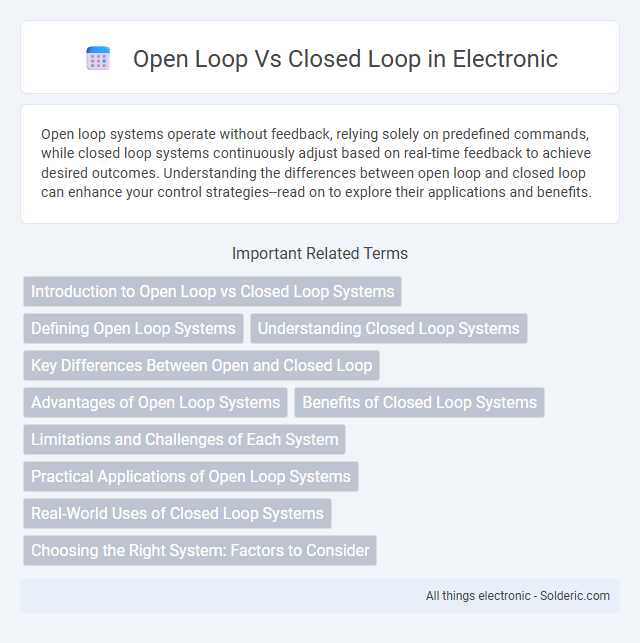Open loop systems operate without feedback, relying solely on predefined commands, while closed loop systems continuously adjust based on real-time feedback to achieve desired outcomes. Understanding the differences between open loop and closed loop can enhance your control strategies--read on to explore their applications and benefits.
Comparison Table
| Feature | Open Loop | Closed Loop |
|---|---|---|
| Definition | System operates without feedback. | System uses feedback to control output. |
| Control | Pre-set control actions. | Dynamic adjustments based on feedback. |
| Accuracy | Lower accuracy, prone to disturbances. | Higher accuracy and stability. |
| Complexity | Simple design and less costly. | Complex design with higher cost. |
| Examples | Washing machines, traffic lights. | Thermostats, cruise control systems. |
| Response to disturbances | No automatic correction. | Automatically corrects errors. |
| Use cases | Suitable for predictable systems. | Ideal for variable environments. |
Introduction to Open Loop vs Closed Loop Systems
Open loop systems operate without feedback, relying solely on input signals to control output, making them simpler but less accurate. Closed loop systems use feedback to continuously monitor and adjust performance, ensuring precision and stability in various applications. Understanding these fundamental differences helps you select the appropriate system based on control requirements and environmental factors.
Defining Open Loop Systems
Open loop systems operate without feedback, meaning the output does not influence the input control action. These systems perform predetermined functions based on initial settings, making them simpler but less adaptable to changes or disturbances. Your control process in an open loop system relies solely on input commands without adjustments from output feedback.
Understanding Closed Loop Systems
Closed loop systems continuously monitor output through feedback to automatically adjust inputs, ensuring precise control and stable performance. Unlike open loop systems, closed loop designs minimize errors and adapt to disturbances, making them ideal for applications requiring accuracy such as temperature regulation, motor speed control, and automated manufacturing. Understanding how your system responds to feedback can significantly improve efficiency and maintain desired outcomes consistently.
Key Differences Between Open and Closed Loop
Open-loop systems operate without feedback, meaning the output is not measured or adjusted based on the system's performance, resulting in simpler design but potential inaccuracies. Closed-loop systems continuously monitor output through feedback sensors and adjust inputs to maintain desired performance, providing higher precision and adaptability. Understanding these key differences helps you choose the appropriate control system for applications requiring stability and accuracy.
Advantages of Open Loop Systems
Open loop systems offer simplicity and cost-effectiveness since they do not require feedback mechanisms, reducing complexity in design and maintenance. These systems operate with predictable, steady-state inputs, making them ideal for processes where output variation is minimal or non-critical. You benefit from faster response times and easier implementation compared to closed loop systems, especially in applications where precision control is not essential.
Benefits of Closed Loop Systems
Closed loop systems enhance accuracy and stability by continuously monitoring output and making real-time adjustments, reducing errors and improving performance. They provide greater efficiency in industrial automation and control processes, enabling precise regulation of variables such as temperature, pressure, and speed. This dynamic feedback mechanism also minimizes energy consumption and material waste, contributing to cost savings and sustainability.
Limitations and Challenges of Each System
Open loop systems face limitations such as lack of feedback, making them unable to correct errors or adapt to disturbances, which results in reduced accuracy and reliability. Closed loop systems confront challenges related to system complexity, increased cost, and potential instability due to feedback delays or noise interference. Balancing responsiveness and stability remains a critical difficulty in the design and implementation of closed loop control mechanisms.
Practical Applications of Open Loop Systems
Open loop systems are widely used in applications where feedback is unnecessary, such as household appliances like washing machines and microwaves that perform tasks based on preset instructions. These systems are cost-effective and simpler to design, making them ideal for processes with predictable, consistent conditions. Your choice of an open loop system suits environments where precise control is less critical, and operational simplicity is preferred over accuracy.
Real-World Uses of Closed Loop Systems
Closed loop systems are integral in maintaining accuracy and efficiency in real-world applications such as industrial automation, HVAC control, and robotic motion control. These systems continuously monitor output through sensors and adjust inputs to meet desired performance criteria, ensuring stability and adaptability in dynamic environments. Examples include automatic temperature regulation in smart thermostats and precise motor speed control in manufacturing equipment.
Choosing the Right System: Factors to Consider
Choosing between open loop and closed loop control systems depends on factors such as precision requirements, system complexity, and environmental conditions. Open loop systems suit applications with predictable inputs and minimal need for feedback, offering simplicity and lower cost. Closed loop systems are ideal for dynamic environments demanding high accuracy and adaptability, utilizing sensors to continuously adjust based on feedback.
Open loop vs Closed loop Infographic

 solderic.com
solderic.com